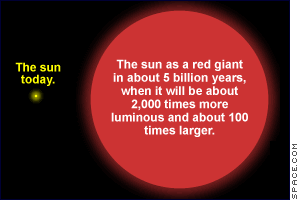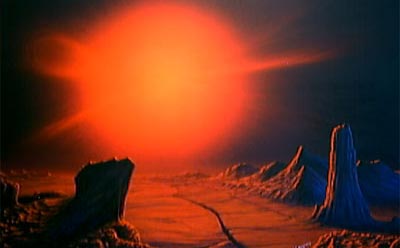Science Fiction
Dictionary
A B C D E F G H I J K L M N O P Q R S T U V W X Y Z
Dying Stars And Planets To Live On

Astronomers have long thought that the best place for life as we know it is a planet in the "habitable zone" - the range of orbits that leads to planets with liquid water - surrounding a main sequence star like our sun. Science fiction writers know better - and now astronomers are rethinking past work.

(Our sun as a red giant)
American astrophysicist William Danchi, and French colleagues Bruno Lopez and Jean Scheider, argue that the search for planets should not be limited to main sequence stars like our sun. The main sequence is only the first stable period of our sun's life; when it begins to burn its hydrogen around a growing helium core it offers another period of several billion years of stability. Finally, stars that have the right mass eventually become red giants; the temperature of the star's core increases as it shrinks, but the outer layers expand and cool. The "habitable zone" of a red giant (like the sun will be) extends from about 630 million miles to 2 billion miles.
Danchi, Lopez and Schneider argue that about 150 sub-giant and red giant stars are situated within 100 light years of Earth (compared to about 1,000 main sequence stars). NASA's Terrestrial Planet Finder space mission will focus only on main sequence stars. These stars will have habitable planets that are further from their suns, and will therefore be easier to find in the glare of the parent stars.

(Roter Riese)
Science fiction authors have long used red giant stars as a convenient location for alien civilizations; often, it is used to denote the planet of a very ancient and wise civilization. In his 1953 novel Childhood's End, Arthur C. Clarke describes the planet of the Overlords who came to help Earth through a difficult developmental stage:
This was the supreme moment of his life: now he was to be the first human being ever to look upon a world lit by another sun...It was cold, though not uncomfortably so. The light from the great red sun low down on the horizon was quite ample for human eyes, but Jan wondered how long it would be before he yearned for greens and blues. Then he saw that enormous, wafer-thin crescent reaching up the sky like a great bow placed beside the sun. He stared at it for a long time before he realized that his journey was not yet altogether ended. That was the world of the Overlords. This must be its satellite, merely the base from which their vessels operated.
Read more at Dying stars could make frozen planets habitable. You might also like Planets May Wander Alone and Massive Planetoids From Beyond The Solar System. If you are concerned that the Earth will no longer lie in the "habitable zone" when our sun becomes a red giant, read what science fiction authors have had to say about moving a planet.
Scroll down for more stories in the same category. (Story submitted 3/29/2005)
Follow this kind of news @Technovelgy.| Email | RSS | Blog It | Stumble | del.icio.us | Digg | Reddit |
Would
you like to contribute a story tip?
It's easy:
Get the URL of the story, and the related sf author, and add
it here.
Comment/Join discussion ( 0 )
Related News Stories - (" Space Tech ")
Will Space Stations Have Large Interior Spaces Again?
'They filed clumsily into the battleroom, like children in a swimming pool for the first time, clinging to the handholds along the side.' - Orson Scott Card, 1985.
Reflect Orbital Offers 'Sunlight on Demand' And Light Pollution
'I don't have to tell you about the seven two-mile-diameter orbital mirrors...'
Chrysalis Generation Ship to Alpha Centauri
'This was their world, their planet ó
this swift-traveling, yet seemingly moveless vessel.' - Nat Schachner, 1934
The First Space Warship For Space Force
'Each of the electrical ships carried about twenty men...' - Garrett P. Serviss, 1898.
Technovelgy (that's tech-novel-gee!) is devoted to the creative science inventions and ideas of sf authors. Look for the Invention Category that interests you, the Glossary, the Invention Timeline, or see what's New.
Science Fiction
Timeline
1600-1899
1900-1939
1940's 1950's
1960's 1970's
1980's 1990's
2000's 2010's
Current News
Boring Company Vegas Loop Like Asimov Said
'There was a wall ahead... It was riddled with holes that were the mouths of tunnels.'
Rigid Metallic Clothing From Science Fiction To You
'...support the interior human structure against Jupiterís pull.'
Is The Seattle Ultrasonics C-200 A Heinlein Vibroblade?
'It ain't a vibroblade. It's steel. Messy.'
Roborock Saros Z70 Is A Robot Vacuum With An Arm
'Anything larger than a BB shot it picked up and placed in a tray...'
A Beautiful Visualization Of Compact Food
'The German chemists have discovered how to supply the needed elements in compact, undiluted form...'
Bone-Building Drug Evenity Approved
'Compounds devised by the biochemists for the rapid building of bone...'
Secret Kill Switch Found In Yutong Buses
'The car faltered as the external command came to brake...'
Inmotion Electric Unicycle In Combat
'It is about the size and shape of a kitchen stool, gyro-stabilized...'
Grok Scores Best In Psychological Tests
'Try to find out how he ticks...'
PaXini Supersensitive Robot Fingers
'My fingers are not that sensitive...'
Congress Considers Automatic Emergency Braking, One Hundred Years Too Late
'The greatest problem of all was the elimination of the human element of braking together with its inevitable time lag.'
The Desert Ship Sailed In Imagination
'Across the ancient sea floor a dozen tall, blue-sailed Martian sand ships floated, like blue smoke.'
The Zapata Air Scooter Would Be Great In A Science Fiction Story
'Betty's slapdash style.'
Thermostabilized Wet Meat Product (NASA Prototype)
There are no orbiting Michelin stars. Yet.
Could Crystal Batteries Generate Power For Centuries?
'Power could be compressed thus into an inch-square cube of what looked like blue-white ice'
India Ponders Always-On Smartphone Location Tracking
'It is necessary... for your own protection.'
